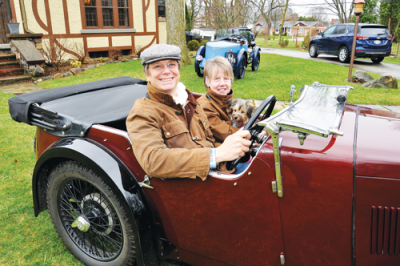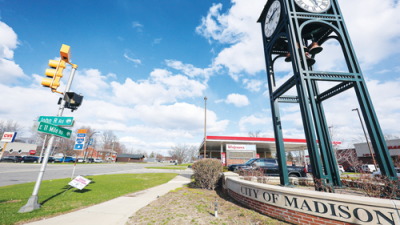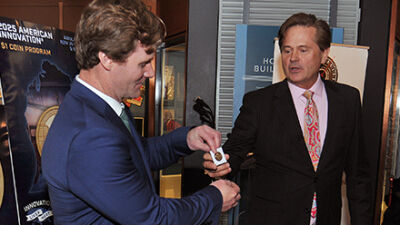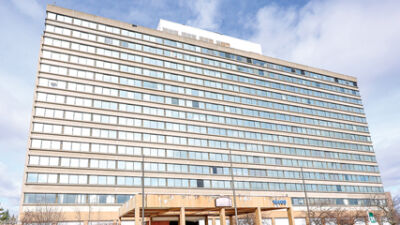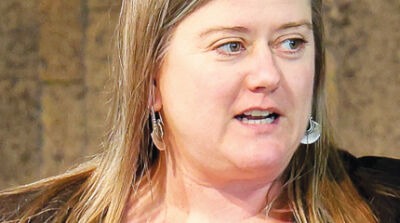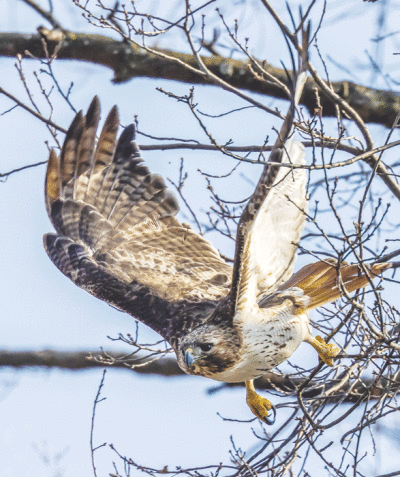
A red-tailed hawk swoops down near the Red Oaks Nature Center at Suarez Friendship Woods. Two of them have created a nest in the canopy near the patio.
Photo by Jeff and Teri Williams

Benjamin Prowse, full-time naturalist at the Red Oaks Nature Center, has been using binoculars to watch the hawks as they build their nest and prepare to lay eggs. The nature center hosts programs throughout the year, including a maple sugaring demonstration in the spring.
Photo by Patricia O’Blenes
MADISON HEIGHTS — The Red Oaks Nature Center at Suarez Friendship Woods has a reputation as a quiet getaway in the middle of a bustling city. But it’s also a wildlife habitat, home to all sorts of animals.
Recently, a breeding pair of red-tailed hawks have been sighted there, building a nest above the patio of the nature center at 30300 Hales St., on the south side of 13 Mile Road, west of Dequindre Road, across from the Red Oaks Waterpark. The hawks also started a second nest deeper in the woods, but abandoned it after a high-wind event.
Red-tailed hawks are named for their reddish tails when mature, and are also recognizable by their distinctive belly bands. If their cry sounds familiar, there’s a reason for that: movies often replace the screech of bald eagles with the tougher-sounding call of red-tailed hawks. Blue jays even mimic it to distract nesting hawks so that they will leave their nests to investigate, at which point the blue jays swoop in and dine on the unprotected eggs.
Benjamin Prowse, a full-time naturalist for Oakland County Parks and Recreation, said it’s been fun watching the red-tailed hawks and other species that call Suarez Friendship Woods home.
“I was part time with the parks here for about 10 years, so to be able to come back this past year and a half in a full-time capacity has been great — being able to see when the red-breasted nuthatch arrive from winter migration, and when the dark-eyed junco are heading out. It’s kind of haphazard when you’re part time; you don’t get the same continuity. So, I’ve been really enjoying being here on a daily basis. I have a much better handle now on what’s happening in the park and in the neighborhoods, between the coyotes and the deer we’re now getting, and so on.
“Especially with the red-tailed hawks,” he said. “I’m so excited, but also a bit leery since they haven’t finished building their nest yet. They’re very close to completion, and I suspect the female will be laying eggs soon. One of the final stages is lining the nest with evergreen sprigs, and we’ve seen them doing that. It seems like a matter of time now before the eggs are laid. It’s going to be so cool the next couple of months, seeing the chicks fledge and learning how to fly and hunt. Our squirrel population is definitely going to decrease — it already has — but we have plenty of them here.”
Prowse said red-tailed hawks are among the most numerous in the Americas, stretching from Central America across North America into northern Canada. Western ones appear darker in color, with less streaking than eastern ones. They’re non-migratory birds since they have a knack for finding food all year-round.
Red-tailed hawks are typically seen soaring on thermals over open fields near highways. Traditionally, they’ve left woodland habitats to other birds such as sharp-shinned hawks. In the case of Suarez Friendship Woods, the park was already home to some Cooper’s hawks, which nested above the trails along the park boundary near Simonds Elementary School.
This led to a skirmish last summer when a red-tailed hawk was seen hunting a gray squirrel in the forest, only to be immediately attacked by a nesting Cooper’s hawk after capturing its prey, chasing the red-tailed hawk out of the park.
But since then, a pair of red-tailed hawks have moved in, nesting in the canopy of a tree about 60 feet up. They’ve been seen taking turns building the nest and capturing squirrels. Prowse said the female was quite vocal with the male once until he flew to another branch and let her dine on the remainder of his squirrel dinner — a sign of courtship feeding.
Up to three eggs are expected, which will require 30-35 days of incubation by both the male and female. After they hatch, the babies will need another 45 days to fledge — a process where their feathers grow large enough for flight. Prowse said females tend to reuse nests in the future, so it’s possible the nature center may see multiple generations of hawks born at its doorstep.
As such, the staff has been adding signage along the trail and near the patio that informs guests of the hawks’ presence, asking visitors to respect their space by passing through quickly or quietly taking a detour around the nest.
Nesting birds can get territorial during breeding season, and hawks are no exception. This can include dive bombing anyone that gets too close. If a hawk feels threatened, they may even forcefully expel their feces to repel others, something Prowse said is called “whitewashing.” And patrons should keep any pets on a leash while outside, since the hawks can easily pick up small dogs and cats, including from backyards, although it’s rare.
Prowse said the hawks were first brought to his team’s attention in mid-February by visitors Jeff and Teri Williams, who have returned regularly to check on the progress of the nest. The park is a birding hot spot, especially in late April and early May as the warblers come through, so the addition of red-tailed hawks is sure to draw attention.
The park is also home to herds of deer that come and go freely since the park does not have a fenced boundary. This past winter saw a 10-point buck along with three does and three fawns. Red foxes have also been seen, and occasionally coyotes hunting squirrels as well. The coyotes have also been spotted near the golf course, waterpark and in the Red Run across Dequindre Road.
The park itself spans 37 acres, with about 1.5 miles of paved trails. The oldest trees are estimated to be between 100 and 150 years old. Prowse said the southern portion of the park has been wooded and wet since at least 1937, and very likely since the late 1800s. The park also encompasses some of the last remaining mesic flatwoods in southeast Michigan, characterized by plants such as cottonwoods, hickories and sycamores that thrive in damp soil.
There is also a stand of hawthorns, which have inches-long thorns to protect them from browsers like the extinct giant ground sloth. Many wildflowers emerge in the spring and throughout the summer and fall, including mayapple, red and white trillium, goldenrods, Jack-in-the-pulpits and asters. There are also invasive species such as garlic mustard and buckhorn.
The Red Oaks Nature Center has big plans for the near future, as outlined in the five-year master plan now available for review at oaklandcountyparks.com. This includes the possible addition of a new teaching pavilion, which would increase the capacity for nature education programs, allowing larger school groups to schedule field trips there. Other projects include native plantings in garden beds around the nature center, updating the bird-feeding station, and additional parking.
Roslyn Grafstein, the mayor of Madison Heights, relishes the place.
“I love being in nature; I love that the woods are right here. I’ll bike there in the summer, and I’ll bike around there, too. I just think that being in nature has a profound positive impact on people of all ages. You can take your time there and enjoy it. It’s nice that when it’s hot, there’s shade to keep you cool. When my kids were younger, we even went there for their educational programs, like the one where you make maple syrup,” Grafstein said.
On Saturday, March 25, from 1:30 p.m. to 3:30 p.m., the nature center will host that program again, where guests can learn about the sugaring process, tapping a tree in the sugar bush. Attendees will hike the park’s Storybook Trail, lined with framed pages from the book “The Sweetest Season,” by Michigan author Elissa Kerr. There will also be sample maple treats, and maple recipes to take home.
All ages are welcome, and the cost is $10 per person. Preregistration is required by calling (248) 585-0100.
As for the hawks, you can follow their progress online at Facebook.com/ocparks, on Twitter (@ocparksandrec) and at oaklandcountyparks on Instagram. You can visit the nature center from 10 a.m. to 5 p.m. Tuesday through Saturday, and from noon to 5 p.m. on Sunday. Binoculars are available for viewing, and the naturalists are happy to point out the nest.
“I think that the nature center and Suarez Friendship Woods is one of the best-kept secrets in the region, and I’d love for more people to be made aware of it,” said Mark Bliss, the mayor pro tem of Madison Heights. “Back when my dad was growing up in Madison Heights, it was referred to as Simonds Woods, and later named after George Suarez, a former mayor and county commissioner and incredible pillar of the community. And previous councils well before my time invested into that nature center, and despite multiple economic challenges have been able to save it and preserve it — and, thanks to the partnership with the county that Oakland County Commissioner Gary McGillivray put into place, we’ve even been able to improve it.
“I actually proposed to my wife on the trails there,” Bliss added. “It’s just such a beautiful hidden gem, and something you wouldn’t expect in a completely built-out community. So yeah, I truly hope everyone who hasn’t set foot on the trails there or walked into the nature center itself will take some time to do just that. It’s pretty awesome.”
Prowse said the nature center is worth visiting all times of the year.
“Seeing the season change, the birds migrate, everyone waking up from hibernation — it’s a real pleasure,” Prowse said. “We want to give people an understanding of nature so that they can appreciate nature, and then learn how to protect it for the next generation. We’re trying to lay the groundwork so that people don’t have to be afraid of the woods.”
 Publication select ▼
Publication select ▼